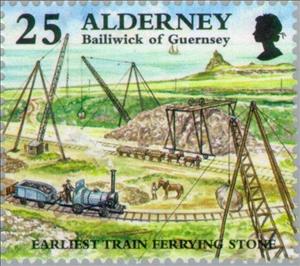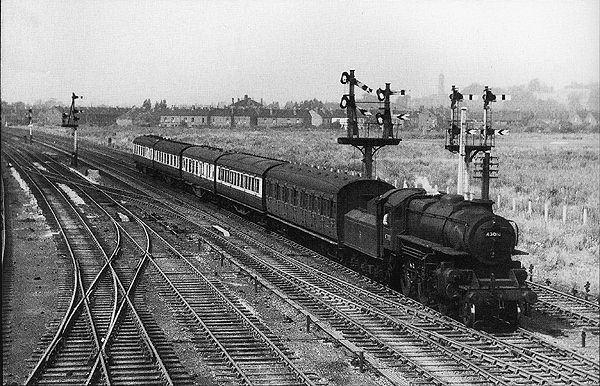Stamp: 150th Anniv of Harbour - Quarry Railway (Alderney 1997)
150th Anniv of Harbour - Quarry Railway (Alderney 1997)
20 November (Alderney ) within release Garrison Island goes into circulation Stamp 150th Anniv of Harbour - Quarry Railway face value 25 Guernsey penny
| Stamp 150th Anniv of Harbour - Quarry Railway in catalogues | |
|---|---|
| Michel: | Mi:GG-AL 111 |
| Stanley Gibbons: | Sg:GG-AL 105 |
Stamp is square format.
Printed Se-Tenant in strips of 2 (SGA104 to SG105)Also in the issue Garrison Island:
- Stamp - 150th Anniv of Harbour - Railway under Construction face value 18;
- Stamp - 150th Anniv of Harbour - Ariadne at Anchor face value 18;
- Stamp - 150th Anniv of Harbour - Quarrying Stone face value 25;
- Stamp - 150th Anniv of Harbour - Quarry Railway face value 25;
- Stamp - 150th Anniv of Harbour - Queen Victoria & Prince Albert face value 26;
- Stamp - 150th Anniv of Harbour - Guard of Honour face value 26;
- Stamp - 150th Anniv of Harbour - Railway Workers face value 31;
- Stamp - 150th Anniv of Harbour - Royal Party face value 31;
- Se-tenant - 150th Anniv of Harbour face value 2*18;
- Se-tenant - 150th Anniv of Harbour face value 2*25;
- Se-tenant - 150th Anniv of Harbour face value 2*26;
- Se-tenant - 150th Anniv of Harbour face value 2*31;
Stamp 150th Anniv of Harbour - Quarry Railway it reflects the thematic directions:
A port is a maritime facility comprising one or more wharves or loading areas, where ships load and discharge cargo and passengers. Although usually situated on a sea coast or estuary, ports can also be found far inland, such as Hamburg, Manchester and Duluth; these access the sea via rivers or canals. Because of their roles as ports of entry for immigrants as well as soldiers in wartime, many port cities have experienced dramatic multi-ethnic and multicultural changes throughout their histories
Mammals are any vertebrates within the class Mammalia (/məˈmeɪli.ə/ from Latin mamma "breast"), a clade of endothermic amniotes distinguished from reptiles (including birds) by the possession of a neocortex (a region of the brain), hair, three middle ear bones and mammary glands. All female mammals nurse their young with milk, secreted from the mammary glands. Mammals include the largest animals on the planet, the great whales. The basic body type is a terrestrial quadruped, but some mammals are adapted for life at sea, in the air, in trees, underground or on two legs. The largest group of mammals, the placentals, have a placenta, which enables the feeding of the fetus during gestation. Mammals range in size from the 30–40 mm (1.2–1.6 in) bumblebee bat to the 30-meter (98 ft) blue whale. With the exception of the five species of monotreme (egg-laying mammals), all modern mammals give birth to live young. Most mammals, including the six most species-rich orders, belong to the placental group. The largest orders are the rodents, bats and Soricomorpha (shrews and allies). The next three biggest orders, depending on the biological classification scheme used, are the Primates (apes and monkeys), the Cetartiodactyla (whales and even-toed ungulates), and the Carnivora (cats, dogs, seals, and allies).
The horse (Equus ferus caballus) is one of two extant subspecies of Equus ferus. It is an odd-toed ungulate mammal belonging to the taxonomic family Equidae. The horse has evolved over the past 45 to 55 million years from a small multi-toed creature, Eohippus, into the large, single-toed animal of today. Humans began to domesticate horses around 4000 BC, and their domestication is believed to have been widespread by 3000 BC. Horses in the subspecies caballus are domesticated, although some domesticated populations live in the wild as feral horses. These feral populations are not true wild horses, as this term is used to describe horses that have never been domesticated, such as the endangered Przewalski's horse, a separate subspecies, and the only remaining true wild horse. There is an extensive, specialized vocabulary used to describe equine-related concepts, covering everything from anatomy to life stages, size, colors, markings, breeds, locomotion, and behavior.
Railways - Transportation system made up of metal rails which is designed to allow trains to maneuver on the tracks from one location to the next.
Animals are multicellular, eukaryotic organisms of the kingdom Animalia (also called Metazoa). All animals are motile, meaning they can move spontaneously and independently, at some point in their lives. Their body plan eventually becomes fixed as they develop, although some undergo a process of metamorphosis later on in their lives. All animals are heterotrophs: they must ingest other organisms or their products for sustenance.





